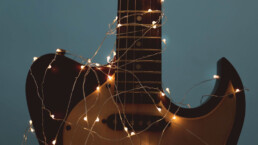The holiday season is upon us, and what better way to spread the Christmas cheer than with some electrifying tunes on your guitar? If you're an intermediate electric guitarist looking to add a rockin' twist to your festive repertoire, you're in the right place. In this blog, we'll explore five Christmas songs that are perfect for intermediate players to master on their electric guitars. So, plug in, turn up the amp, and let's make this holiday season one to remember!
RELATED: Learn how to play guitar at TrueFire >
Jingle Bell Rock
Difficulty: Intermediate
Kicking off our list is the timeless classic, "Jingle Bell Rock." Originally performed by Bobby Helms, this upbeat and jazzy tune is a perfect fit for the electric guitar. Master the catchy chord progressions, and don't forget to throw in some rock-inspired riffs to give it that extra edge. You'll have everyone at your Christmas party tapping their feet to the rhythm.
Run Rudolph Run
Difficulty: Intermediate
Chuck Berry's "Run Rudolph Run" is a high-energy Christmas song that's tailor-made for electric guitar enthusiasts. The song's driving rhythm and infectious energy make it a joy to play. Work on nailing the iconic Chuck Berry-style riffs, and you'll have a crowd-pleaser that captures the spirit of rock and roll during the holidays.
Wonderful Christmastime
Difficulty: Intermediate
Paul McCartney's "Wonderful Christmastime" offers a different flavor with its synth-driven sounds, but that doesn't mean it can't be adapted for electric guitar. Experiment with power chords and add a touch of distortion to capture the song's festive spirit. The upbeat tempo and McCartney's signature melodic hooks make this one a delight to play and hear.
Feliz Navidad
Difficulty: Intermediate
José Feliciano's "Feliz Navidad" brings a Latin flair to the Christmas season. This song is relatively simple but provides an excellent opportunity to incorporate some fingerpicking techniques on your electric guitar. Embrace the festive rhythm, and you'll have a heartwarming rendition that stands out from the usual holiday playlist.
Blue Christmas
Difficulty: Intermediate
Elvis Presley's melancholic "Blue Christmas" may not be the typical upbeat holiday tune, but it's a fantastic choice for showcasing your guitar skills. Experiment with arpeggios and chord embellishments to capture the emotional essence of the song. Add a touch of reverb for that vintage sound, and you'll have a bluesy Christmas ballad that tugs at the heartstrings.
Conclusion:
Whether you're entertaining friends and family or simply enjoying some solo practice time, these intermediate-level songs will add a dash of musical magic to your festive celebrations. So, pick up your guitar, crank up the volume, and let the joyous sounds of Christmas resonate through your strings. Merry rocking Christmas!
RELATED: Learn how to play guitar at TrueFire >
December 13, 2023
In a world filled with digital distractions and rapidly changing trends, introducing a timeless and enriching skill to the younger generation can be a game-changer. Learning to play the guitar at a young age is not just about mastering chords and strumming patterns; it's a transformative experience that goes beyond the realm of music. In this blog post, we'll explore the profound significance of picking up a guitar during the formative years of life.
RELATED: Learn to play guitar at ANY age at TrueFire >
Cognitive Benefits:
Research has shown that learning to play an instrument, including the guitar, has a positive impact on cognitive development. The brain's plasticity is at its peak during childhood, making it an ideal time to acquire new skills. Playing the guitar engages various parts of the brain simultaneously, enhancing memory, concentration, and problem-solving skills.
Emotional Expression:
The guitar is a powerful tool for emotional expression. For young individuals navigating the challenges of growing up, having a creative outlet like playing the guitar can be invaluable. Music allows them to express emotions that might be difficult to put into words, fostering a healthy means of communication and self-discovery.
Discipline and Patience:
Mastering the guitar is a journey that requires discipline and patience. Learning to play chords, scales, and songs takes time and effort. The process of practicing regularly, facing challenges, and gradually improving teaches valuable life skills. These qualities, instilled at a young age, can translate into success in various aspects of life, from academics to personal relationships.
Social Connection:
Music has a universal language that transcends cultural and linguistic barriers. Learning to play the guitar provides an opportunity for young individuals to connect with others who share similar interests. Whether it's forming a band, joining a music class, or simply jamming with friends, playing the guitar fosters a sense of community and collaboration.
Boost in Confidence:
As young learners see their progress on the guitar, they gain a sense of accomplishment and self-confidence. Performing in front of an audience, even if it's just friends and family, builds resilience and public speaking skills. These experiences contribute to a well-rounded individual who is comfortable with self-expression and facing challenges head-on.
Lifelong Guitar Passion:
Learning to play the guitar at a young age often sparks a lifelong passion for music. The skills acquired during these formative years lay the foundation for a deep and lasting connection to the art of making music. This passion can become a source of joy, stress relief, and personal fulfillment throughout one's life.
Conclusion:
In a world where technology is ubiquitous and trends come and go, the guitar stands as a timeless and enduring instrument. Learning to play the guitar at a young age is not just about creating musicians; it's about nurturing well-rounded individuals with enhanced cognitive abilities, emotional intelligence, and a lifelong appreciation for the art of making music. As parents, educators, and mentors, introducing the guitar to the younger generation is a gift that keeps on strumming, enriching lives and shaping futures.
RELATED: Learn to play guitar at ANY age at TrueFire >
December 12, 2023
In the ever-evolving landscape of American music, few bands have stood the test of time quite like Asleep at the Wheel. Led by the towering figure of Ray Benson, this band has not only preserved the legacy of Western swing but has also infused it with a contemporary zest that continues to attract fans across generations.
RELATED: Check out Ray Benson's first course on TrueFire today >
The Early Days: A Dream Takes Root
In the early 1970s, a young, ambitious Ray Benson formed Asleep at the Wheel with friends in Paw Paw, West Virginia. Inspired by the sounds of Bob Wills and His Texas Playboys, they had a dream: to revive Western swing, a genre that blends country, jazz, blues, and swing. This dream took them from West Virginia to East Oakland and finally to Austin, Texas, where they became part of a burgeoning music scene that welcomed their unique sound.
Rising to Fame: The Austin Years
It was in Austin where Asleep at the Wheel truly found their footing. Their blend of honky-tonk, boogie, and swing quickly made them a staple in the local music scene. Albums like "Comin' Right At Ya" (1973) and "Texas Gold" (1975) not only showcased their musical prowess but also their dedication to keeping Western swing alive. Hits like “The Letter That Johnny Walker Read” became anthems that transcended the borders of Texas.
Ray Benson: The Towering Man with a Towering Vision
At the heart of Asleep at the Wheel’s success is Ray Benson, the 6-foot-7-inch frontman whose deep voice and charismatic presence have become synonymous with the band. Benson's leadership and vision have been pivotal in navigating the band through numerous lineup changes and the shifting tides of the music industry. His commitment to authenticity and musical innovation has earned him not only a loyal fan base but also respect among his peers.
More Than Just a Band: Cultural Preservationists
Asleep at the Wheel isn’t just a band; they are cultural preservationists. They have kept Western swing alive, introducing it to new audiences and reminding the world of its significance in American music history. Their efforts culminated in projects like “Ride with Bob” (1999) and “Still the King: Celebrating the Music of Bob Wills and His Texas Playboys” (2015), albums that paid homage to their biggest influence, Bob Wills, and featured collaborations with artists across various genres.
Legacy and Influence: The Wheel Keeps Rolling
Over their five-decade career, Asleep at the Wheel has released over 25 albums, won 10 Grammy Awards, and influenced countless artists. They've become a fixture in not just the country music scene but in the broader American music narrative. Their influence can be seen in the works of contemporary artists who blend genres, breaking traditional boundaries much like Asleep at the Wheel did in their early days.
The Unstoppable Journey Continues
As we look at the legacy of Ray Benson and Asleep at the Wheel, it's clear that they are much more than a band. They are storytellers, historians, and innovators. Their journey is a testament to the power of passion and perseverance. As they continue to tour and produce new music, one thing is certain: the wheels of Western swing will keep rolling, and Ray Benson will be at the helm, steering it into the future.
RELATED: Check out Ray Benson's first course on TrueFire today >
December 8, 2023
As a guitar player, you may dream of being the frontman, basking in the spotlight with your solos and riffs. However, the role of a sideman in a band is equally, if not more, crucial. The sideman supports the main artist or band leader, which requires a unique set of skills, often overlooked but vital for the success of any musical group.
RELATED: Learn the Art & Craft of the Sideman by G.E. Smith at TrueFire >
Here are the top 10 skills you’ll need to develop to become the consummate sideman:
1. Musical Versatility
The ability to adapt to different musical styles is paramount. A good sideman should be comfortable playing various genres, from jazz to rock, blues to country. This versatility not only makes you more employable but also enriches your musicality.
2. Solid Rhythm Playing
While solos are impressive, a sideman's primary role is to provide a solid rhythmic foundation. Your ability to lock in with the drummer and bassist, creating a tight rhythm section, is crucial for the overall sound of the band.
3. Listening Skills
A great sideman listens more than he plays. Being attentive to the dynamics, tempo, and feel of the music allows you to complement rather than overpower the main act.
4. Professionalism
Professionalism encompasses punctuality, preparedness, and a positive attitude. Being reliable and easy to work with makes you an asset to any band.
5. Ego Management
As a sideman, the spotlight isn’t on you. It's essential to keep your ego in check and focus on enhancing the performance of the bandleader or the main artist.
6. Quick Learning Ability
Often, sidemen are required to learn new material quickly, sometimes with little rehearsal. The ability to pick up songs fast, by ear or through reading music, is a valuable skill.
7. Adaptability On The Stage
Things don’t always go as planned during live performances. Being able to adapt to changes, whether it’s a setlist alteration or a technical issue, is crucial.
8. Backing Vocals
If you can sing, you're a double threat. Providing backing vocals adds depth to the band's sound and makes you more versatile as a musician.
9. Equipment Knowledge
Understanding your gear, from your guitar to your amp settings, and how it fits into the overall sound of the band, is essential. This knowledge allows you to quickly adjust your tone to suit different songs or venues.
10. Networking and Relationship Building
Building good relationships with other musicians and industry professionals can lead to more opportunities. Networking is key in the music business.
Becoming an excellent sideman is about blending skill with humility and versatility with reliability. It's about being the band’s backbone, often unnoticed but indispensable.
As a guitar player, honing these skills not only makes you a valuable band member but also enriches your musical journey, opening doors to diverse and rewarding opportunities.
The best sidemen often become the best leaders, as they understand every nuance of what makes a band successful. So, embrace the role, and you'll be surprised at how it elevates your musicianship and career.
RELATED: Learn the Art & Craft of the Sideman by G.E. Smith at TrueFire >
December 7, 2023
The Soulful Slide: Exploring the Influence of Slide Guitar in Country Music
Country music, with its roots deeply embedded in the American landscape, has a unique ability to capture the essence of life's highs and lows. One of the most distinctive and soul-stirring elements contributing to the genre's signature sound is the slide guitar. With its hauntingly beautiful tones and emotive slides, this instrument has left an indelible mark on the fabric of country music.
RELATED: Learn to play slide guitar from the legends at JamPlay + TrueFire >
The Birth of Slide Guitar:
The origins of slide guitar can be traced back to the blues, where it first gained popularity among African American musicians in the early 20th century. However, it wasn't long before its mournful cries found their way into the heart of country music. The technique involves sliding a smooth object, typically a metal or glass tube, along the strings of a guitar to produce a distinctively fluid sound.
Influential Pioneers:
Several pioneers played pivotal roles in popularizing slide guitar in country music. One of the earliest legends was Sylvester Weaver, who recorded the first known slide guitar track, "Guitar Blues," in 1923. As the years rolled on, other icons like Tampa Red and Kokomo Arnold embraced the slide, laying the foundation for its integration into the country genre.
The Resonator Revolution:
The introduction of resonator guitars in the 1920s further revolutionized the slide guitar's role in country music. With its metal body and distinctive cone-shaped resonator, this instrument produced a louder and more resonant sound, making it ideal for the stage. Artists like DeFord Bailey, a harmonica player for the Grand Ole Opry, showcased the resonator's capabilities, setting the stage for its widespread adoption in the country scene.
The Honky-Tonk Era:
The honky-tonk era of the 1940s and 1950s saw the rise of country legends who skillfully wielded the slide to convey heartache and longing. Hank Williams, often regarded as the father of contemporary country music, used the slide to punctuate the melancholy tales of love and loss that defined his music. The lonesome wail of the slide guitar became synonymous with the emotional depth inherent in country storytelling.
The Bakersfield Sound:
In the 1950s and 1960s, the Bakersfield Sound emerged as a counterpoint to the polished Nashville sound. Artists like Buck Owens and Merle Haggard embraced the raw, twangy tones of the slide guitar, infusing their music with a gritty realism that resonated with working-class audiences. The Bakersfield Sound not only revived the prominence of the slide but also influenced subsequent generations of country musicians.
Contemporary Country and Beyond:
As country music evolved over the decades, the slide guitar continued to play a vital role in shaping its diverse subgenres. From the outlaw country movement of the 1970s, with artists like Willie Nelson and Waylon Jennings, to the neo-traditionalists of the 1980s, such as George Strait, the slide guitar remained a powerful tool for conveying emotion and adding authenticity to the music.
Conclusion:
From its humble beginnings in the blues to becoming a cornerstone of the country genre, this style has left an indelible mark on the hearts of listeners worldwide. As country music continues to evolve, the haunting slide guitar will undoubtedly remain an essential element, ensuring that its soulful echoes persist for generations to come.
RELATED: Learn to play slide guitar from the legends at JamPlay + TrueFire >
Martin Guitar is thrilled to announce its collaboration with TrueFire, the world’s leading platform for online guitar lessons. Together, they have created The Martin Lesson Room, a dedicated online platform for guitar enthusiasts to immerse themselves in state-of-the-art, interactive, innovative music lessons. Visit martinguitar.com/martin-lesson-room to get started.
The Martin Lesson Room goes beyond conventional guitar instruction. Every lesson is crafted by celebrated Martin artists, ensuring that learners receive guidance that’s both authentic and deeply rooted in the rich heritage of guitar music.
Dive Deep with TrueFire’s Signature Learning Experience:
Precision Meets Clarity: With multi-angle HD video lessons, witness guitar artistry from perspectives that matter.
Interactive Learning: Synchronized video and tab interactivity mean learners will never miss a beat (or a note). This unique feature allows instantaneous visual and auditory feedback, enabling faster and more efficient learning.
Customized Playback: Slow down without altering pitch, loop challenging segments, and progress at your own pace. TrueFire’s state-of-the-art player enhances the video lesson experience.
Jam Along: Exclusive jam tracks allow students to practice in real-time, simulating a live band experience.
“The partnership between Martin and TrueFire represents a meeting of giants. Both entities are committed to delivering the highest quality in their respective domains,” said Zach Wendkos, Chief Revenue Officer of TrueFire Studios. “With The Martin Lesson Room, we are combining the legacy and artistry of Martin guitars with the pedagogical expertise of TrueFire. It’s an experience that’s unmatched.”
This unique learning platform is exclusively available to Martin Backstage members. Membership grants access to the vast reservoir of lessons and ensures that your library is ever-evolving, with fresh content added monthly.
“At Martin, we believe anyone who picks up a guitar is an artist,” said Michael Nelson, VP of Marketing at Martin Guitar. “And we’re always looking for ways to help and inspire artists at any point in their journey. By partnering with TrueFire to build The Martin Lesson Room, we can do just that. Their technology and user experience are second to none, and we’re excited to offer this world-class lesson program to our fans.”
We invite media professionals, guitar aficionados, and curious learners to explore the brilliance of The Martin Lesson Room. For press inquiries, interviews, or exclusive previews, please contact Kate Richardson at kate@richlynngroup.com.
Join us in this celebration of music, learning, and legacy. Because at The Martin Lesson Room, every chord tells a story. Visit martinguitar.com/martin-lesson-room to get started.
December 5, 2023
Your electric guitar is not just a musical instrument; it's a companion, an extension of your creativity, and an investment. To ensure it stands the test of time and continues to produce the sweetest of sounds, proper care is paramount. In this blog, we'll delve into the secrets of caring for your electric guitar to promote longevity, keeping it in top-notch condition for years to come.
RELATED: Learn how to play Electric Guitar today >
Storage Matters:
Temperature and Humidity Control:
Your guitar is sensitive to environmental changes. Extreme temperatures and humidity can lead to warping, cracking, or damage to the instrument. Store your electric guitar in a cool, dry place, and consider using a humidifier or dehumidifier, depending on your climate.
Proper Guitar Stand or Case:
When not in use, always keep your guitar on a stable stand or store it in a quality case. This protects it from accidental knocks, spills, and dust accumulation, safeguarding its overall well-being.
Regular Cleaning Routine:
Wiping Down the Guitar:
After every playing session, wipe down your guitar with a soft, lint-free cloth. This helps remove oils, sweat, and dirt that can accumulate over time. Pay extra attention to the strings, fretboard, and body.
Polishing and Conditioning:
Periodically, use a suitable guitar polish to maintain the shine of the finish. Additionally, condition the fretboard with a recommended wood conditioner to prevent it from drying out or cracking.
String Maintenance:
Regular String Changes:
Strings naturally degrade over time due to playing, exposure to air, and sweat. Change your strings regularly to maintain tone and playability. The frequency depends on your playing habits, but a general rule is to change them every 3-6 months.
Cleaning the Strings:
After playing, wipe down your strings with a clean cloth to remove residue. This not only prolongs the life of the strings but also enhances their sound.
Adjusting Truss Rod and Action:
Truss Rod Adjustment:
Understanding how to adjust the truss rod is crucial for maintaining the proper curvature of the neck. If you notice changes in the neck's bow, consult your guitar's manual or seek professional assistance.
Action Adjustment:
The action, or the height of the strings above the fretboard, can impact playability. Adjust the action according to your playing preference, but be cautious not to set it too low, risking fret buzz.
Electronics and Hardware Check:
Tightening Loose Hardware:
Regularly check the hardware, including nuts, bolts, and screws. Loose components can affect the guitar's playability and lead to more severe damage.
Cleaning Electronics:
If your guitar has exposed pickups, pots, or switches, use compressed air to remove dust and debris. Be cautious not to damage any wiring.
Professional Maintenance:
Annual Check-ups:
Just like a car needs regular maintenance, your electric guitar benefits from occasional professional care. A luthier can perform a thorough check-up, address any issues, and ensure your guitar stays in peak condition.
Conclusion:
Caring for your electric guitar is a labor of love that pays off in the form of prolonged longevity and exceptional performance. By following these guidelines and investing time in regular maintenance, you can keep your instrument in top-notch condition, ready to produce beautiful music for years to come. After all, a well-cared-for guitar is not just a tool; it's a testament to your commitment to the craft and the art of making music.
RELATED: Learn how to play Electric Guitar today >
December 4, 2023
Bluegrass jams are a storied tradition where guitarists, banjo pickers, fiddle players, and vocalists gather to share tunes, stories, and the joy of music. These sessions are communal, energetic, and a great way to improve your musicianship. Here's how musicians of all stripes can come together and make beautiful, foot-stomping music at your next bluegrass jam.
RELATED: Learn Bluegrass techniques from Ned Luberecki & Stephen Mougin >
1. Know Your Bluegrass Repertoire
Whether you're strumming, picking, bowing, or singing, familiarity with bluegrass standards is key. Tunes like "Foggy Mountain Breakdown" and "Will the Circle Be Unbroken?" are jam staples. Spend time learning the classics—your fellow jammers will appreciate it.
2. Tune-Up and Stay in Tune
In the world of bluegrass, being in tune is non-negotiable. With a mix of guitars, banjos, fiddles, and voices, even slight tuning issues can be glaring. Use a reliable tuner, and check your tuning often, especially if you're playing an instrument like the banjo that can drift out of tune quickly.
3. Practice Your Chops
Rhythm is the driving force in bluegrass. Guitar and banjo players should practice their "chop"—the muted strum that keeps the beat. Fiddlers should work on shuffles and chops that accent the rhythm. Vocalists can contribute with rhythmic phrasing and tapping.
4. Learn to Take Turns
Bluegrass jams often feature round-robin soloing. Know when to step up for your break and when to step back. Respect the unspoken order of solos, and don't hog the spotlight. Remember, bluegrass jam etiquette is all about sharing the stage.
5. Develop Your Ear
Bluegrass is an aural tradition with improvisation at its heart. Ear training is essential. The ability to pick up tunes and harmonies by ear will make you a valuable jam partner. Work on recognizing common chord progressions and melody lines.
6. Harmonize Naturally
For vocalists, the ability to harmonize by ear is a prized skill. Listen closely and find your part, whether it's a high tenor or a deep baritone. The high, lonesome sound of bluegrass comes alive with tight, spontaneous harmonies.
7. Be Prepared to Adjust
Bluegrass jams can be unpredictable. You might need to capo up to match a fiddle's key or adapt a guitar part for a banjo-led tune. Flexibility is crucial, so practice playing in different keys and adapting on the fly.
8. Focus on Tone and Technique
The right technique can make or break your sound. Banjo players should hone their rolls, guitarists their flatpicking, fiddlers their bowing, and vocalists their clarity and pitch control. And for all, a clean, authentic tone is what gives bluegrass its distinctive sound.
9. Bring the Right Gear
Arrive at the jam session with everything you need. This includes picks, capos, extra strings, and any personal amplification gear if it's a larger venue. Ensure your instrument is in good repair—bluegrass can be demanding on strings and setups.
10. Engage with the Bluegrass Community
Bluegrass is as much about community as it is about music. Network with other players, share tips and tunes, and enjoy the camaraderie. You might find yourself invited to more private pickings or even gig opportunities.
The heart of bluegrass is in its jam sessions, where musicians of all instruments and skill levels come together to celebrate this uniquely American art form. Knowing the standards, staying in tune, mastering rhythm, observing etiquette, training your ear, harmonizing, staying adaptable, focusing on technique, bringing the right gear, and engaging with the community are all critical for a successful jam.
Whether you're a guitarist, banjoist, fiddler, or vocalist, these tips will help you fit right into the circle, bring something special to the group, and leave with a sense of accomplishment and new friends in the bluegrass scene. So grab your instrument, warm up those vocal cords, and dive into the rich, collaborative world of bluegrass jamming. There's no better way to grow as a musician or livelier way to make music.
RELATED: Learn Bluegrass techniques from Ned Luberecki & Stephen Mougin >
December 1, 2023
One of the most effective paths to developing your own musical identity is by first learning to play like your guitar heroes. This journey of emulation, exploration, and eventual innovation is a time-honored tradition in the world of music. Let's delve into why this process is so crucial for guitar players.
RELATED: Check out My Guitar Heroes: Monster Mike Welch >
Standing on the Shoulders of Giants
Learning the Language of Guitar
Every guitar hero, from Jimi Hendrix to Eddie Van Halen, started as a student of their predecessors. By learning to play like your guitar heroes, you're learning the language of the guitar. This includes understanding different playing styles, techniques, and the emotional expression unique to each player. It's akin to a writer learning the rules of grammar before they start experimenting with their own style.
Technical Mastery through Imitation
Imitating your guitar heroes allows you to develop technical proficiency. You'll learn complex chords, innovative picking techniques, and unique bends and vibratos that define the sound of these legends. This technical foundation is essential; you can only break the rules effectively once you know them inside out.
The Art of Expression
Guitar playing is not just about technique; it's about expression. By studying your heroes, you learn how they convey emotions through their instrument. Whether it's the soulful bends of B.B. King or the fiery solos of Stevie Ray Vaughan, each artist has a way of telling a story through their guitar. You start to understand how to inject emotion into every note you play.
Assimilating and Innovating
Finding Your Unique Voice
Once you've immersed yourself in the styles of your guitar heroes, the next step is assimilation. This involves blending what you've learned with your own musical tastes and influences. It's a process of experimentation, where you mix and match different elements from various artists to see what resonates with your personal style.
Creativity Through Constraints
Initially, imitating others might seem like a constraint, but it's within these constraints that creativity often flourishes. By setting boundaries based on another's style, you push yourself to think differently to play differently. This is where innovation begins.
The Journey of Musical Discovery
As you continue to play and experiment, you'll start making small changes – a different bend here, a unique riff there. Over time, these changes accumulate, and your own style begins to emerge. This is your musical identity – a culmination of your influences, experiences, and personal expression.
Embracing the Evolution
Continuous Growth
Your musical journey continues once you've found your style. Music, like any art form, is constantly evolving. As you grow as a person and as a musician, your style will evolve too. The influences of your guitar heroes will always be a part of your playing, but how you express those influences will change.
The Legacy of Learning
Remember, the guitar heroes you admire were once in your shoes. They learned from their heroes, developed their style, and eventually became influences for future generations. By following in their footsteps, you're not just developing your musical identity; you're also becoming a part of this timeless legacy.
Learning to play like your guitar heroes is more than just imitation. It's a vital step in your journey as a musician. It's about understanding the roots of guitar playing, mastering the technical aspects, and then using that knowledge as a springboard for your creativity.
Your musical identity is a unique blend of your influences and your personal expression. Embrace this journey, and let the legacy of the greats inspire you to find your own voice in the world of music.
RELATED: Check out My Guitar Heroes: Monster Mike Welch >
November 30, 2023
The holiday season is synonymous with music, and what better way to celebrate than by strumming along to classic Christmas tunes on your guitar? If you're a beginner or simply looking for a hassle-free way to spread festive cheer, we've got you covered. In this blog post, we'll explore five timeless Christmas songs that you can effortlessly play with just four chords. Grab your guitar, tune it up, and let the musical merriment begin!
RELATED: Learn the chords to play these songs at TrueFire >
"Jingle Bells"
Chords: G, C, D, Em
Jingle Bells is a perennial favorite that captures the joyful essence of Christmas. With a straightforward chord progression, you can easily recreate the cheerful jingle and jangle of this classic.
Pro tip: Experiment with different strumming patterns to add your own flair to this festive favorite.
"Feliz Navidad"
Chords: C, G, Am, E7
Inject a bit of Latin flair into your holiday repertoire with Jose Feliciano's "Feliz Navidad." The four chords create a lively rhythm, making it impossible for listeners to resist the urge to dance along.
Pro tip: Emphasize the E7 chord for an extra touch of authenticity in capturing the song's cheerful spirit.
"Rudolph the Red-Nosed Reindeer"
Chords: C, G7, F, D7
Rudolph's tale comes to life with just four chords, making it an ideal choice for those seeking a festive and easy-to-play Christmas classic. Sing along with the iconic story of the red-nosed reindeer who saves Christmas!
Pro tip: Experiment with chord inversions to add variety and dynamics to your rendition.
"Last Christmas"
Chords: D, Bm, Em, A
George Michael's "Last Christmas" is a pop sensation that translates beautifully to the guitar with a straightforward chord progression. Capture the bittersweet essence of the song while keeping the holiday spirit alive.
Pro tip: Play around with the song's dynamics by incorporating variations in strumming intensity.
"Santa Claus Is Coming to Town"
Chords: C, Am, Dm, G
Bruce Springsteen's rendition of this holiday classic is legendary, and you can recreate its magic with just four chords. Capture the anticipation of Santa's arrival with this upbeat and jolly tune.
Pro tip: Experiment with a mix of strumming and picking to add a dynamic touch to your performance.
Conclusion
With these five Christmas songs, you can easily spread joy and holiday spirit with your guitar. Whether you're playing for friends and family or just strumming along by the fireplace, these songs are sure to add a festive touch to your musical celebrations. So, deck the chords and let the holiday tunes ring!
RELATED: Learn the chords to play these songs at TrueFire >
November 29, 2023










